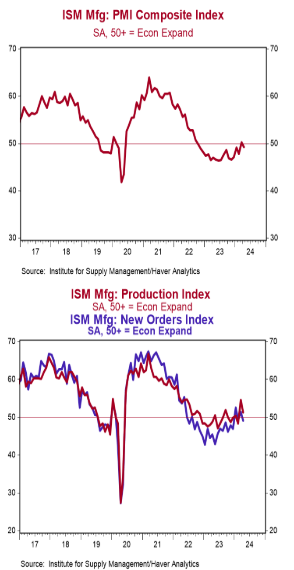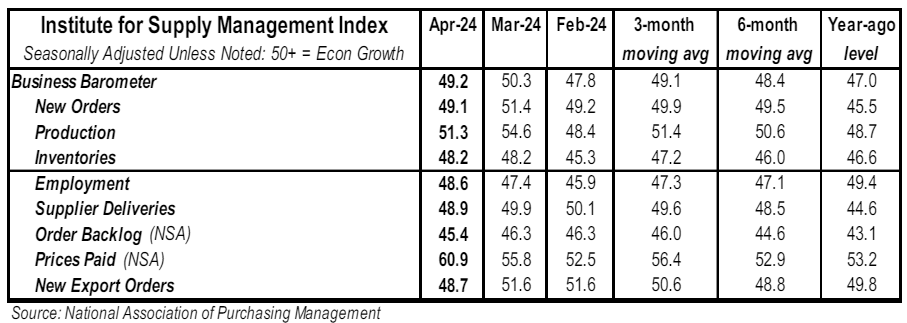- The ISM Manufacturing Index declined to 49.2 in April, lagging the consensus expected 50.0. (Levels higher than 50 signal expansion; levels below 50 signal contraction.)
- The major measures of activity were mostly lower in April. The new orders index declined to 49.1 from 51.4 in March and the production index fell to 51.3 from 54.6. The employment index rose to 48.6 from 47.4 in March, while the supplier deliveries index declined to 48.9 from 49.9.
- The prices paid index increased to 60.9 in April from 55.8 in March
Implications:
After a brief one-month stint above 50, the ISM Manufacturing index missed consensus expectations and fell to 49.2 in April. Activity in the US manufacturing sector has now contracted for seventeen out of the last eighteen months. Looking at the details of the report, half of the eighteen major manufacturing industries reported growth in April, with seven reporting contraction, and two reporting no change. Both demand and production were responsible for the drop in the overall index, with the index for production softening to 51.3 and the new orders index falling back into contraction territory at 49.1. This marks the eighteenth month in the last twenty where the new orders index has been below 50. With production skating along and demand dragging, companies have turned to reducing their order backlog. That index, which currently sits at 45.4, has been in contraction for nineteen consecutive months. Survey comments from manufacturing companies remain mostly optimistic that their backlogs can get them through the end of the year when conditions are expected to improve, but despite this optimism, demand remains weak. Looking at the big picture, goods-related activity was artificially boosted during the COVID lockdowns, but then the economy reopened, and consumers started shifting their spending preferences back to services and away from goods. The ISM index peaked in the last month federal stimulus checks were sent out (March 2021) and has been weaker ever since. Meanwhile, it’s counterpart survey on the service sector – the ISM Services index – keeps chugging along. The worst part of today’s report came from the highest reading of any category – the prices paid index – which jumped to 60.9 in April. Inflationary pressures have been on the rise in the manufacturing sector this year, as comments about increasing costs are showing up once again in the report after being absent for most of 2023. This is not a welcome sign for the Fed, as the goods sector was a key driver for lower inflation readings last year. In other news this morning, ADP’s measure of private payrolls increased 192,000 in April versus a consensus expected 183,000. We expect Friday’s payroll report to show a nonfarm payroll gain of 225,000. Meanwhile, construction spending declined 0.2% in March, as a large drop in homebuilding more than offset increases for highway & street projects as well as educational facilities. Finally, on the housing front, home prices rose in February, with the national Case-Shiller index up 0.4% and the FHFA index jumping 1.2%. In the last twelve months, these indices are up 6.4% and 7.0%, respectively.





